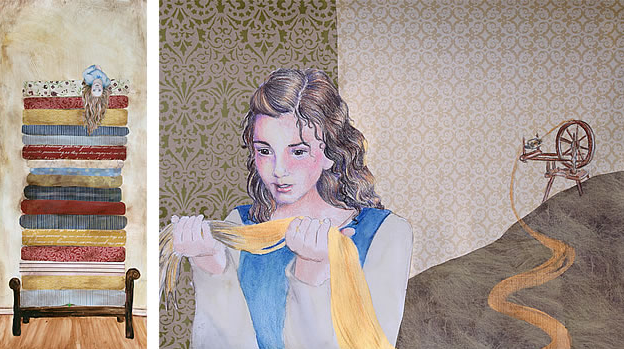How to draw & paint faster: 10 tips for high school Art students
Are you struggling to get your Art projects done on time? Some students – even those who are dedicated and hard-working – find it challenging to work at the pace required in a Visual Art course. The skilful, perfectionist student usually falls into this category; those who produce meticulous, highly-detailed observational drawings or paintings. Parents and teachers can be unsure how to provide practical, positive strategies for improvement. This article lists fifteen ways that a high school Art student can work faster, without compromising the quality of their work.
- Use a ground
There are many benefits to working on a ground. One of these is increased painting or drawing speed. A ground covers a painting or drawing surface from the outset. It can act as mid-tone, with only black and white used to apply dark and light areas (as in the examples below) or be left partially visible in the final work. This results in an artwork that is much faster to complete (see our article about painting on grounds for more information).

- Incorporate mixed media /patterned surfaces / textural elements
As with using a ground, patterned, decorative or textural items can cover areas of an artwork quickly. Although this strategy should be used with care, selecting only materials which support or enhance your project (usually with reference to a relevant artist model) this can be a great way to speed up your project and introduce creative use of mixed media.

- Work on several pieces at once
Working in series – completing several paintings or drawings at one time – is a very helpful strategy for Art students. This speeds work up for a number of reasons:
A single colour can be used throughout a number of works, without needing to stop for remixing / washing brushes
While one work is drying, another one can be worked on
Similar processes or techniques can be mastered quickly and repeated on subsequent works
In addition, when working on several pieces at once, ‘preciousness’ about the work tends to be lost, leading to more experimentation and greater work speed.

- Paint things in the right order – background areas first
Painting things in an illogical order is surprisingly common amongst high school Art students. In almost all cases, the background should be completed first, followed by the middle-ground, ending with the foreground. This is easily understood when considering a tree in front of a cloudy sky. If you make the mistake of painting the tree first, the sky has to be meticulously painted around every leaf and branch: an irritating task that takes hours (and ends up looking a little shabby). Painting the sky first, however, means that a large brush can quickly be used to paint the sky, with the tree then easily added over the top. Painting in the correct order also results in a painting that has layers (which gives it a richness and lustre, as with using a ground). If you find that subsequent layers of paint do not adequately cover earlier ones, you have an inferior brand of paint. (We will detail our paint and art supply recommendations in an upcoming article – stay tuned)!

- Use masking tape to create straight edges
Some students are concerned that it might be necessary to ‘prove’ that a straight line can be painted by hand. This is not the case. Your control of a paint brush can be ascertained immediately by looking at the remainder of your painting. Masking tape creates straight edges in seconds. Once mastered, this trick can save you hours – and make your paintings sharper, cleaner and more professional in the process. If you haven’t used masking tape before, buy some now!

- Leave artwork purposefully incomplete
Artist work is sometimes purposefully ‘unfinished’. Art students shouldn’t feel obliged to ‘complete’ every item. There are many occasions when a fully rendered drawing is not necessary. Drawings, especially those in sketchbooks, can be left with edges trailing away and tone only applied to some areas. Leaving work unfinished is particularly useful when conducting visual research, exploring ideas and experimenting with media. Depending on your artist influences, this may even be appropriate in final works – as a way to draw attention to focal points and direct attention within an artwork.

- Omit parts of a scene
Deliberately picking out certain parts of a scene to draw has a strong impact on the final work and must be used with care to ensure that the resulting image supports the ideas explored in your project. As with the previous option, this allows you to demonstrate strong observational drawing skills, while saving time by omitting part of the scene.

- Selectively flatten tone
Another option that students have is to flatten tone – to remove the smooth blending gradations from dark to light. This strategy should be used with caution – and usually only in certain areas – as unintentionally flattening tone can be the hallmark of a weak student. As indicated by the artist examples below, however, there are times when all or parts of the tonal variation within an artwork can be omitted with great success.

- Focus on Line
There are many occasions where it may be appropriate for a high school student to draw using only line (it is often the application of tone that is time-consuming for students, so working exclusively with line can provide a welcome relief). Blind drawings, contour drawings, cross contour drawings and other hatched drawings (please see our collection of beautiful line drawings for ideas) can form an important part of your project.
- Include photographs
While there is a certain quantity of painting and drawing that must take place within a Painting or Fine Art portfolio, photography can provide an excellent mechanism for moving a project forward at a faster pace.


Good tips, @chocolate2018
Great info here.